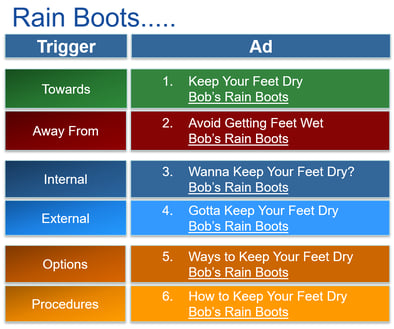On Season 4, Episode 37 of Unleashed, Shelle Rose Charvet walks us through the 6 different motivational patterns people can have, and how to use the right language to influence each.
Actions You Can Take Right Now

- Evaluate the language in incoming emails. Are they written in toward language, or away from language? Do the senders want your input/solution (external), or are they deciding for themselves (internal).
- Meet them at their bus stop. Write your replies using language that will influence the sender’s state. Talk about problems to avoid for someone in away mode, and solutions and benefits for someone in toward. Present options to someone who is internal.
- Use the Suggestion Model and Bad News Formula. Write them on a sticky note and keep it on your computer – every day brings opportunities to practice. See Episode Highlights below for the steps.
View or listen to this and other past episodes at www.unleashresults.com/unleashed-series
Take Your Business to the Next Level
At Results we care about your success, we understand how overwhelming it can feel to run a business, and we’re here to help. Reach out to Nicole through our contact form for ways to unleash the potential of your business.
Visit the Unleashed Podcast Library where you’ll find exclusive conversations with world-class thought leaders, authors, and leadership experts.
Each episode of Unleashed is hosted by Results’ CEO Jeff Tetz who spends most of his day exploring what makes high performers tick and helping build a community of leaders who want to learn and grow together. Follow Jeff (Twitter; LinkedIn; Instagram) for more great leadership insights.
Episode Highlights and Excerpts
- Everyone receives and processes information differently, and instinctively we all know this. Despite this we tend to use language that motivates us when trying to influence others, and that doesn’t always work. Instead, we need to figure out what is going to motivate our audience.
- We can do this by asking questions, such as
- What would you like to get out of this experience today? OR
- How will you know that we’ve done a good job for you?
- Based on a person’s answers to these questions, we can determine their motivational state, and then tailor our language to motivate.
- A person’s motivational pattern is very contextual and can change from one situation to the next. When we first become aware of a problem, we’re in “away” mode and are trying to escape that problem. Then we start our research, become aware of the market leaders in the solution space, and switch to “external mode”. In this state we are open to receiving advice from others.
- As a business we have to guard against using command language too early in the sales process. We need credibility and trust established before we can use language like “you should do this”. If uncertain, present options.
- In marketing, try testing out different language patterns. Run beta testing on two ads or social posts that communicate the same product or service. Try one with language that suggests the recipient wants to move away from a problem. The other should suggest the recipient wants to move toward a solution. See the rain boots example below.
- Deliberate language can help with giving feedback. The traditional feedback sandwich model (something good, something bad, something good) only causes people to not hear the good parts. Instead, separate positive recognition into a separate conversation and try out the 4 Step Suggestion Model:
- Tell the recipient you have a suggestion and ask if they would like to hear it. Present the solution.
- Explain what the suggestion would prevent, avoid, or solve (the problem, or what to move away from)
- Talk about the benefit (what the solution moves toward)
- Why it’s easy
- Thoughtful language can also make delivering bad news far easier. Use the Bad News Formula:
- Deliver the bad news
- Say BUT, then
- Deliver three pieces of good news
- Example: I don’t have your cheque ready yet, but I am meeting with our finance team today, and I’m going to put your invoice in front of them, and I can let you know as soon as I’ve done that so you’ll know when you’ll get paid.
- For each of us personally, it is helpful to know that long term motivation for behavioral change benefits greatly from two influences: away from (the problem you are avoiding) and toward (the future vision).
Access the Full Episode Your Way
Click the logo below to subscribe to your favorite platform and never miss another episode recording:
Remember to subscribe to your favorite channel and be the first to know when new conversations are available.
Shelle Rose Charvet
Shelle Rose Charvet is the founder of The Institute for Influence and Success Strategies consulting and training. She is a bestselling author and the international expert on Influencing Language, researching and teaching for over 35 years.
Her first book, Words That Change Minds, is an international bestseller, available in 15 languages, and a Forbes best management book. Organizations in over 30 countries ask her to help them increase their impact and influence.
She started learning Neuro-linguistic Programming (NLP) in 1982 in Paris after immigrating there. As a communication trainer, working in English and French in international organizations such as IBM, UNESCO, CERN, Shelle found using NLP unlocked people’s abilities to think and communicate better.
As part of her NLP training, she was introduced to Rodger Bailey’s Language and Behavior Profile, (LAB Profile®), and
it set her on a decades long journey of discovery and development of tools to help people get their message across.






